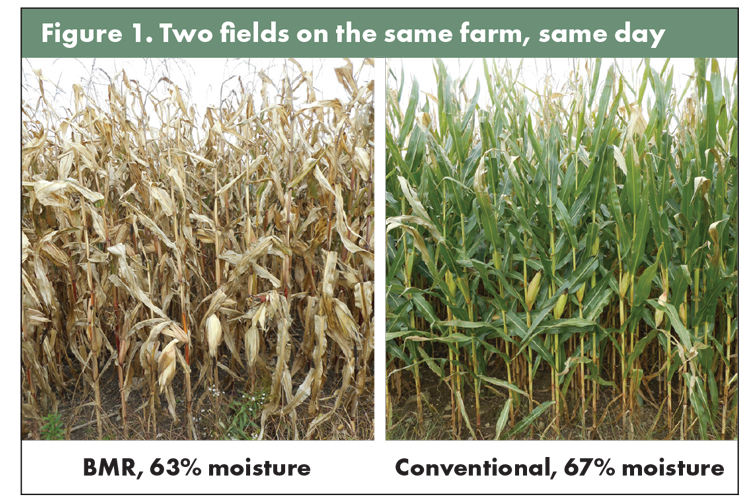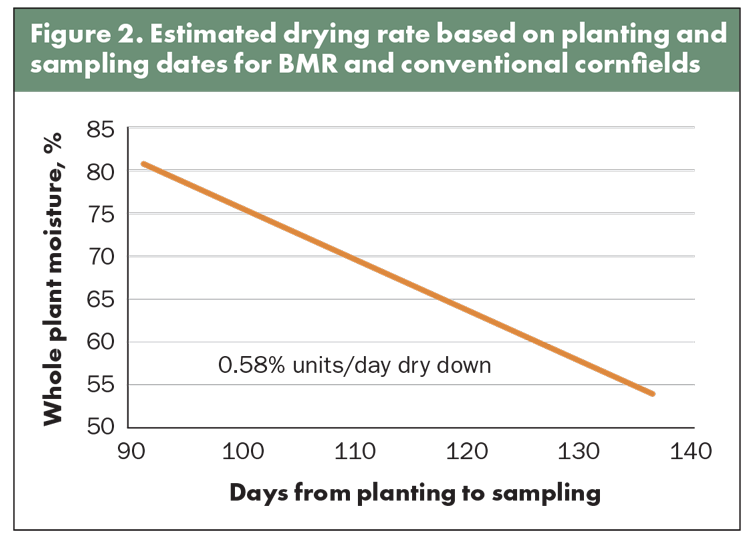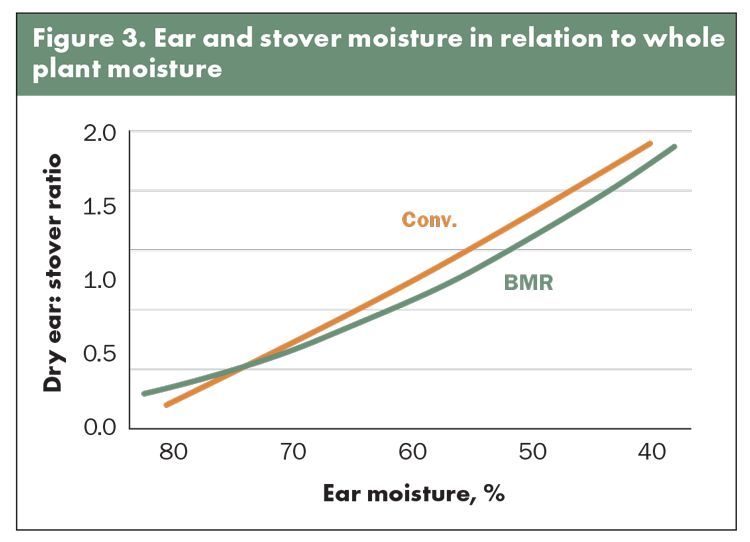
Dairy farms rely heavily on corn silage as a key feed ingredient in cow rations. Moisture assessment in the field is essential for harvest timing of corn silage, but visual assessment is problematic, particularly for brown-midrib (BMR) hybrids. Although BMR hybrids have proven higher nutritive value than conventional types, they tend to be more susceptible to disease and lodging compared to nonBMR hybrids (Figure 1). Historically, there has also been a yield drag associated with BMR hybrids, and BMR corn tends to have less starch than conventional hybrids.

BMR corn plants often visually appear dry due to desiccated leaves; however, leaves account for less than 15% of the total plant dry matter and are typically a poor indicator of whole-plant moisture. BMR hybrids are reported to dry down slower or faster than conventional types, depending on the weather. In 2023, we decided to take a closer look at the differences between BMR and conventional corn hybrids during the harvest period.
Field-to-field variability
Past studies have shown that five representative corn plants can adequately represent the overall moisture content of a field. We selected five plants per field from 202 cornfields on seven farms across three counties in central New York during the fall of last year. The seven farms had a total of about 13,000 acres of corn planted.
Planting dates varied from mid-April to early June, with a wide range of soil types and drainage. Fields were sampled from late August to late September, and the moisture content of ear, stover, and whole plant were measured.
A total of 41 different corn hybrids were sampled, with relative maturities (RM) ranging from 84 to 112 days. Twenty-nine percent of the fields were planted to BMR hybrids. Plant height, ear length, and ear width were also measured. Adequate precipitation across the region during much of the growing season resulted in normal corn development for most of the sampled fields.
Plant height ranged from 5 to 10 feet and ear length from 4 to 9 inches. Ear length and ear width were positively related to total plant dry matter, with only minor differences between BMR and conventional. There was no relationship between ear length and width. The ear-to-stover ratio declined with greater plant height and increased with larger ear width.
Stover moisture of individual plants ranged from 85% to 65% while ear moisture ranged from 83% to 38%. Whole-plant moisture ranged from 84% to 51% from the beginning to end of the sampling period.

We estimated relative rates of whole-plant dry down by comparing sampling date moisture to the number of days from planting to sampling for each cornfield (Figure 2). The drop in whole-plant moisture per day was relatively consistent across RM groups, averaging 0.5 to 0.6 percentage units per day. Drying rate per day of BMR hybrids did not appear to be different from conventional types in upstate New York in 2023.
Some hybrid differences
Ear moisture was highly correlated with whole-plant moisture for both BMR and conventional hybrids (Figure 3). This is due to a strong relationship between ear moisture and ear-to-stover ratio, up until grain fill is completed (Figure 4). Ear moisture averaged 1 to 2 percentage units lower for BMR compared to conventional over the entire sampling date range. Stover moisture averaged nearly 2 percentage units higher for BMR than conventional prior to reaching harvest moisture.

Besides the differences in moisture content for both ear and stover between BMR and conventional, advancing grain fill results in the dry ratio of ear to stover to be nearly 1:1 when the whole plant reaches 68% moisture. On average, we estimate that BMR fields reached 68% whole-plant moisture about the same day as conventional fields. Of course, the harvest date for a particular hybrid will depend on its RM, the planting date, and the seasonal weather.

Less starch for BMR, but . . .
Ear dry matter yield per plant for BMR averaged 7.5% lower than for conventional hybrids at 68% whole-plant moisture. Total dry matter yield for individual BMR plants was similar to conventional hybrids on average. Seed companies recommend that BMR hybrids should be planted at a slightly lower population than conventional, although Cornell University research by Bill Cox found no hybrid by seeding rate interactions for yield or quality, comparing BMR with conventional hybrids.
A 2016 Miner Institute trial found no significant yield differences between BMR and conventional hybrids when planted at the same populations. A 2023 study by Clemson University planted corn at rates from 24,000 to 40,000 plants per acre and also concluded that dry matter yield was not different between BMR and conventional corn hybrids.
As expected, BMR plants had less grain compared to conventional types. Any yield drag for BMR hybrids does appear to be shrinking. Weather in 2023 was not particularly stressful for our study, and it remains likely that BMR hybrids are more susceptible to stress than conventional types. Although BMR plants visually appear to be much drier than conventional hybrids, the difference between them in whole-plant moisture can be relatively small.
On average, BMR hybrids reached 68% whole-plant harvest moisture about the same day as conventional hybrids The excellent relationship between ear moisture and whole-plant moisture should make it possible to estimate whole-plant moisture in the field from an ear moisture estimate.
This article appeared in the August/September 2024 issue of Hay & Forage Grower on pages 24-25.
Not a subscriber?Click to get the print magazine.

